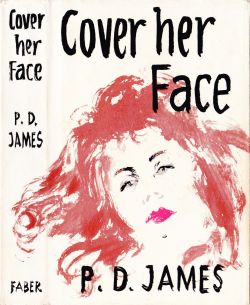 The most collectible P.D. James novel is the 1962 London first edition, of “Cover her Face” that comes with its original dust wrapper and is signed by the author. During the later years of the crime mystery author’s life, the book had been trading around £6,000. A year ago, when Faber & Faber announced the author’s death, the average asking price for the book was reasonably set at £6,500. Not much has changed since then, as collectors, discouraged by the high prices, have turned their attention to less expensive but still attractive alternatives of her work.
The most collectible P.D. James novel is the 1962 London first edition, of “Cover her Face” that comes with its original dust wrapper and is signed by the author. During the later years of the crime mystery author’s life, the book had been trading around £6,000. A year ago, when Faber & Faber announced the author’s death, the average asking price for the book was reasonably set at £6,500. Not much has changed since then, as collectors, discouraged by the high prices, have turned their attention to less expensive but still attractive alternatives of her work.
The belief, that the media attention surrounding the death of a prominent author increases the public interest in the person’s life and works, has not been the norm for authors of recent times. Our research suggests that there are more factors at play affecting supply and demand, and ultimately price, around the time of the loss of a beloved author.
There is no doubt that the prospect of future increases in the supply of the works of living authors is a powerful force to keep prices at bay. While an old, out of print, first edition is limited by the number of surviving copies, the author may produce new material or sign old copies, thus affecting supply. The death of an author, on the other hand, should, under normal circumstances, remove the threat of future supply increases, and given a steady demand, should also cause the price to increase.
In actuality however, supply increases along with prices immediately after the author’s death, as a result of book dealer anticipation of an increase in demand. The increase in supply and asking price immediately following an author’s death is attributed to dealer positioning. Opportunistic dealers that foresee an increase in demand due to media attention are putting their offering up for sale and raising prices.
At this time demand may or may not rise depending on the author’s collectible appeal or what Matheson & Baade refer to as the author’s “nostalgia effect.” 1 Unlike celebrity memorabilia however, authors’ works exhibit little or no demand shifts caused by “nostalgia effect.” In fact, most authors that passed away during the last ten years did not show an increase in demand for their collectibles due to the “nostalgia effect.” In this century, so far, it has been more likely that an author’s serious illness or old age can cause an increase in the value of the author’s work rather than death. The data collected and exhibited below in the two tables strongly supports this hypothesis for famous authors.
Both the subdued nostalgia effect and the media attention surrounding an author’s death are considered a temporary phenomenon.2 Beyond the initial year after the author’s death, without the capacity to incur future supply increases, and given a steady demand, prices are expected to rise. While the “dealer effect” is responsible for the transient nature of the postmortem price increase, the true forces of supply and demand are at work over the longer term.
As is the case with everything else in life, an unfortunate event such as an author’s death, timing is in control and timing determines the value of the valuables left behind through the forces of supply and demand. As science fiction writer, Arthur C. Clarke, could not resist drawing up timelines for what he called “possible futures,” it is quite enjoyable for us too to ponder on the possible future values of rare books.
—————————-
1Matheson, Victor A. & Baade, Robert A. 2003. The “Death-Effect” on Collectible Prices. Department of Economics Williams College Working Papers. http://web.williams.edu/Economics/wp/mathesonmemorabilia.pdf
2Ekelund, R. B., Jr., Resssler, Rand W. and Watson, John Keith (2000) “The ‘Death-Effect’ in Art Prices: A Demand-Side Exploration”. Journal of Cultural Economics, 24: 283-300.


{ 0 comments… add one now }